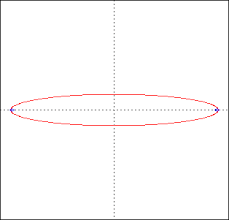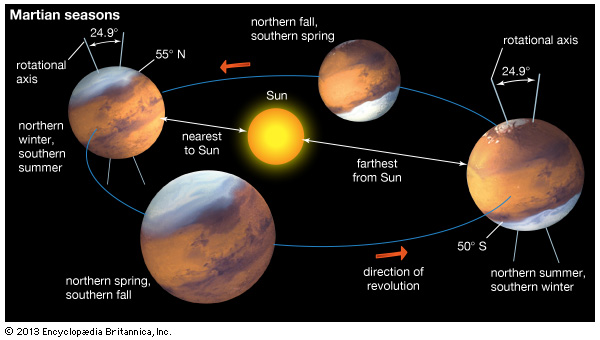The problems in this homework are all related to the discussions we had about the sun, earth, and moon and how they move relative to each other. These motions along with the orientation of the earth's axis lead to seasonal variations that we experience as well as the phases of the moon. These questions are intended to review some of those discussions as well as asking you to explore a little further on your own.
The Seasons and the Earth-Sun relationship:
1: The complicated looking table below gives the tilt of the axis (axial tilt) for each planet. Would you expect Venus to have greater seasonal variation than earth or less or about the same? Explain your reasoning? What about Mars?

2: You are given a mystery planet with an axial tilt of 30 degrees. Decide which direction your planet is going around the orbit and indicate it on the illustration below. Sketch the location of the planet and the orientation of it's axis when it is summer in the southern hemisphere. Label this with a 1. Do the same for the location and orientation of the planet at the fall equinox and label it 2.

3: Mars has a similar axial tilt to that of the earth (25 degrees compared to 23 degrees). The orbit of Mars is much more elliptical than the earth (which is nearly a circle as we discussed). Mars is 20% closer to the sun at it's closest than at its furthest. How will this make the seasons on Mars different than the seasons on earth? Remember that one characteristic of seasons on earth is that summer in the northern and southern hemispheres are pretty much the same. Explain your reasoning.

The Phases of the Moon and the Earth-Moon relationship:
4: The Moon’s right half is illuminated and it is midnight. Where in the sky do you see this Moon? Make a sketch that helps explain your reasoning.
5: What is the phase of the moon during solar and lunar eclipses? Explain your reasoning clearly which probably requires a sketch.
6: Bruce made the statement that everyone in the world sees the same phase of the moon at the same time. This definitely worth check with your FB or Instagram friends around the world. If this is true is it consistent with the mental model the the moon goes around the earth once a day? Explain the reasoning for your answer, sketches may help.
Eclipses and the Sun-Earth-Moon relationship:
7: Here is a link to a you tube video describing the mechanics of solar and lunar eclipses. Watch this video (direct link). How many times during a year is there a possibility of an eclipse? Is it different for lunar and solar exlipses? If the orbit of the moon was not tilted with respect to the earths orbit how many eclipses might we see in a year?
8: Why is it more likely that we would have the opportunity to see a total lunar eclipse than a total solar eclipse?
9: Find the NASA lunar and solar eclipse tables in the Breadcrumbs and Identify the date and time of the next total lunar eclipse that we can see from Central Oregon (what color will it be?). Identify the data, time, and location of the next total solar eclipse in the Western Hemisphere. I just want you to know so you can plan for future watch parties:)
